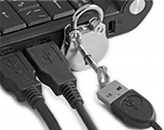- MENU
- HOME
- SEARCH
- WORLD
- MAIN
- AFRICA
- ASIA
- BALKANS
- EUROPE
- LATIN AMERICA
- MIDDLE EAST
- United Kingdom
- United States
- Argentina
- Australia
- Austria
- Benelux
- Brazil
- Canada
- China
- France
- Germany
- Greece
- Hungary
- India
- Indonesia
- Ireland
- Israel
- Italy
- Japan
- Korea
- Mexico
- New Zealand
- Pakistan
- Philippines
- Poland
- Russia
- South Africa
- Spain
- Taiwan
- Turkey
- USA
- BUSINESS
- WEALTH
- STOCKS
- TECH
- HEALTH
- LIFESTYLE
- ENTERTAINMENT
- SPORTS
- RSS
- iHaveNet.com
Marc Saltzman

You can find them in pockets, purses and on key chains. They're on lanyards and in pens, built into some jewelry and even found alongside scissors and nail files in Swiss army knives.
Teeny USB thumb drives are ubiquitous: In fact, Gartner estimates more than 222 million were sold in 2009 alone.
Could such a tiny gadget bring big risks to your organization?
Your Data at Risk
Thanks to their small size, low cost, and capability of instant backup and file transportation between multiple computers, USB drives actually pose significant security threats for businesses.
For example, disgruntled employees can easily make off with sensitive company information on a USB drive. "The threat is not new, but the problem is exacerbated by tiny and cheap USB drives," says Leslie Fiering, research vice president at Gartner in San Jose, Calif. "The moment we had removable storage media -- going back to floppy disk drives -- there have been stories of janitors going onto computers after hours and downloading major amounts of information." Employees who plan on quitting a company -- or perhaps those expecting a pink slip -- can also easily copy over customer or client databases, emails, calendar appointments and contact lists in a matter of seconds, and then take this digital info with them to a competitor.
Increasingly, USB drives can also carry harmful malware, say security experts. USB keys can be used to install viruses or to serve as boot drives to erase data -- even unintentionally. An employee who uses a USB drive on a personal computer at home could carry malware back to a work computer without his or her knowledge.
USB Security: What You Can Do
You should take several precautions to minimize the risk of data theft or malware attacks via USB drives. Consider the following:
Implement strong security software
All company computers should have the right security software to detect and remove potential threats. "Without question, you need serious protection today that not only protects from online threats but also is capable of scanning external devices too, such as USB drives," warns Fiering.
Limit USB access
In extreme cases, organizations have cut off access to USB ports. Others have limited USB access to specific employees. Using encrypted USB drives is another option, as is disabling AutoRun on computers so that programs on a USB drive don’t immediately run when a drive is inserted.
Monitor use
Keeping track of USB access will help you note who is using the drive, on which computer and at what time of day." IT departments need to make sure their machines are secure and sensitive information protected," adds Michael Gartenberg, research director at Gartner in Stamford, Conn.
Focus on education.
“Banning can result in users trying to bypass the ban,” cautions Santorelli. A usage policy augmented by an awareness campaign to educate end users will help mitigate the risks.
Fiering and Santorelli note that these risks are not limited to USB drives. Santorelli calls it an “erosion of the traditional network perimeter” because of the prevalence of mobile devices and the convergence of personal and work technology. “This is a problem that's not going away any time soon," says Fiering. With the right security measures, however, companies can ensure the security of their data, despite today’s increased risks.
IT Insider is a daily editorial resource offering innovative insights and strategies for building an integrated, secure and resilient IT infrastructure.